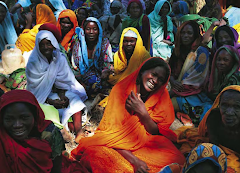Thursday, April 30, 2009
More Refugee Documentaries: Between Earth & Sky


Tuesday, April 28, 2009
Mark Hanis Calls for a Paradigm Shift at NYU
Visit msnbc.com for Breaking News, World News, and News about the Economy
Monday, April 27, 2009
Sunday, April 26, 2009
UNHCR statistics
The United States of America, Canada and France, the top three receiving countries in 2008,
together accounted for one-third of all new asylum claims submitted in industrialized countries.
Together with Italy and the United Kingdom, the top five receiving countries accounted for half
of all asylum claims.

Saturday, April 25, 2009
Influence of Web 2.0
WCAR: April 25th UN Durban II Protest: StandWithUs

 Although i didn't fly to Geneva Switzerland, i was following the convention via twitter updates, blogs such as AJC, JPost, Durban Debacle, and the main news media reports via CNN, BBC, and New York Times.
Although i didn't fly to Geneva Switzerland, i was following the convention via twitter updates, blogs such as AJC, JPost, Durban Debacle, and the main news media reports via CNN, BBC, and New York Times.Thursday, April 23, 2009
UNRWA & Palestinian Refugees

UNRWA: UN Relief and Works Agency for Palestine Refugees in the Near East, which created its own criteria for refugee classification- As such that Palestinians are the only refugee population legally defined to include descendants of refugees, as well as others who might otherwise be considered internally displaced persons.
I personally find the situation in the Palestinian territories to be a matter of great concern that must be resolved. A two state solution is desperately needed but how can such a solution be generated when both parties, that being the Palestinians and Israeli's don't both want it. Conflict Resolution, diplomats, peace seekers- have all attempted for years... what is the missing key?
As of December 2005, the World Refugee Survey of the U.S. Committee for Refugees and Immigrants estimates the total number of Palestinian refugees to be 2,966,100.
Monday, April 20, 2009
Documentary: Well Founded Fear (PBS)
WATCH BELOW
Case-Study Input:
"Well-Founded Fear is a stunning example of documentary filmmaking, beautifully crafted and brilliantly structured to allow viewers to enter into a realm of human experiences and political facts as witnesses, citizens, family members, decision-makers. It is as art, not propaganda, that it finds its great power, entering the social imagination which is so heavily informed by television. It reached three principal groups: the INS, the advocacy community, and general audiences.
The INS: Immigration and Naturalization Service: Camerini and Robertson screened the film at six INS offices. It was also seen by Commissioner Meissner. Officers had varying reactions to the film—. But it was generally agreed that the film had captured the culture of INS offices in a way it had never before been seen, and that it foregrounded the threat of “officer burnout” in this high-stress environment. The film is being used in staff training, and steps are being taken to counter burnout.
Legal and Advocacy Communities. Well-Founded Fear gave national visibility to immigration and asylum issues that are rarely seen on television, except in cases that are politically dramatic (Elian Gonzalez) or extreme (smuggled Chinese workers stranded at sea). It provided legitimacy and support to the work of advocates, like the San Francisco Amnesty worker who said the film would help her organization’s efforts, saying, “The refugee experience is so complicated and hard to convey to the public.” Broadcast and local events have produced pro bono volunteers among law students and lawyers, and the film is used in training asylum workers. Amnesty International, the American Bar Association, and refugee rights organizations are among those who have incorporated the film into their programs. The film has made is in showing immigration advocates how to most effectively advance their cause, demonstrating how persuasive an even-handed approach can be.
General audiences. The PBS broadcast of Well-Founded Fear was seen in over a million households in the U.S., bringing serious asylum and refugee issues into public view. This was compelling television: by drawing viewers into intimate stories of personal crisis, it put a human face on abstract issues, and introduced political asylum into public discourse, providing images and language that enable conversation and debate.
Impact was enhanced by a sophisticated pre-broadcast rollout strategy which was timed to engage movers and shakers first, followed by press, and then civic groups and advocacy organizations. In addition to television broadcast, the film reached general audiences through well-planned events at festivals, libraries, schools, and churches, often with the filmmakers and subject experts present. The synergistic convergence of radio, television, print press, websites, listservs, screenings, and word of mouth produced a vibrant public presence for the film, which is continuing. This is a clear example of how technologies can be used to enhance broadcast and promote on-the-ground activities.
In terms of potential long-term impact, this project has succeeded in opening new public spaces and pathways for civic dialogue; forging relationships between groups willing and able to use and sustain those spaces; and providing language, information, and opportunities for conversation around public issues. Thanks to strategic planning the film has been the subject of informed (often heated) discussion in libraries, schools, foundation offices, television stations, film festivals, living rooms, community meetings, and cyberspace.The group of institutions, organizations, and individuals assembled by the filmmakers as they went about their work, came to constitute an effective, if improvised, infrastructure that sustained the production and circulation of the film, and catalyzed its many uses." -Please See: Documentary Case-Study Information
Sunday, April 19, 2009
Focusing on The Global Refugee Crisis

- What determines refugee status?
- what are the areas in the world with the largest numbers of refugees?
- What are the distinctions drawn between migrants, internally displaced persons, refugees, and those granted asylum- asylum seekers?
Sunday, April 12, 2009
1951 Geneva Refugee Convention

Curious to understand where UNHCR began all of its work i looked into the 1951 Geneva Refugee convention which set the stage for global refugee policy & legal rights. After the General Assembly called forth for the United Nations Conference to meet in Geneva to draft a convention regulating the legal status of refugees, provisions of the convention
 concerning the definition of the term refugee and the principle of non-refoulment were established: i.e that no Contracting state shall expel or return "refouler" a refugee, against his/her will in any manner into a territory where he/she fears persecution.
concerning the definition of the term refugee and the principle of non-refoulment were established: i.e that no Contracting state shall expel or return "refouler" a refugee, against his/her will in any manner into a territory where he/she fears persecution.
- locally integrate refugees
- voluntary return to homeland
- resettlement in 'third' countries (if other two not possible)
Article 1
definition of the term “refugee”
A. For the purposes of the present Convention, the term “refugee” shall
apply to any person who:
(1) Has been considered a refugee under the Arrangements of 12 May 1926
and 30 June 1928 or under the Conventions of 28 October 1933 and 10
February 1938, the Protocol of 14 September 1939 or the Constitution of
the International Refugee Organization;
Decisions of non-eligibility taken by the International Refugee Organ-
ization during the period of its activities shall not prevent the status
of refugee being accorded to persons who fulfil the conditions of para-
graph 2 of this section;
(2) As a result of events occurring before 1 January 1951 and owing to well-
founded fear of being persecuted for reasons of race, religion, national-
ity, membership of a particular social group or political opinion, is out-
side the country of his nationality and is unable or, owing to such fear,
is unwilling to avail himself of the protection of that country; or who,
not having a nationality and being outside the country of his former
habitual residence as a result of such events, is unable or, owing to such
fear, is unwilling to return to it.
In the case of a person who has more than one nationality, the term “the
country of his nationality” shall mean each of the countries of which he
is a national, and a person shall not be deemed to be lacking the protec-
tion of the country of his nationality if, without any valid reason based
on well-founded fear, he has not availed himself of the protection of one
of the countries of which he is a national.
Giving Voice to a Cause

- Darfur
- Democratic Republic of the Congo
- Eastern Burma
- Eastern Chad
- Iraq
- Somalia
- Sri Lanka








